-
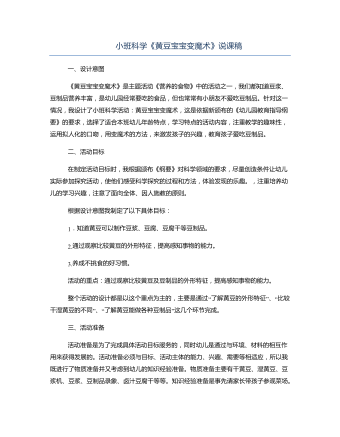
小班科学《黄豆宝宝变魔术》说课稿
二、活动目标在制定活动目标时,我根据颁布《纲要》对科学领域的要求,尽量创造条件让幼儿实际参加探究活动,使他们感受科学探究的过程和方法,体验发现的乐趣。,注重培养幼儿的学习兴趣,注意了面向全体、因人施教的原则。根据设计意图我制定了以下具体目标:1.知道黄豆可以制作豆浆、豆腐、豆腐干等豆制品。2.通过观察比较黄豆的外形特征,提高感知事物的能力。3.养成不挑食的好习惯。活动的重点:通过观察比较黄豆及豆制品的外形特征,提高感知事物的能力。整个活动的设计都是以这个重点为主的,主要是通过“了解黄豆的外形特征”、“比较干湿黄豆的不同”、“了解黄豆能做各种豆制品”这几个环节完成。

小班科学《猜猜它是谁》说课稿
(一)、教育目标如今,科学教育的价值取向不再注重知识的传递,而是注重儿童的的好奇心、求知欲、探索欲和热爱科学的情感。所以,根据这一要求,我将本次活动目标指定如下:1、鼓励幼儿参与科学活动,激发幼儿求知欲及对科学活动的探索精神。2、能从动物的局部判断出是哪种动物,并能合作将动物完整的拼出来。3、通过活动培养幼儿细致的观察能力和动手能力,初步培养幼儿的合作能力。(二)、教材内容方面根据制定的目标,选择相应的内容也是置关重要的。确定了活动《猜猜它是谁》,还要结合我班幼儿的具体情况。我根据主题活动《动物王国》里的内容,结合本次活动,收集相关的游戏材料,巧妙地将一些幼儿认识的动物设计在游戏转盘中,并将这些动物分割成二至四块成为孩子们喜欢的拼图,让幼儿通过这些分割图推断出是哪个动物,及在拼图游戏中让幼儿掌握整体与部分的关系。使幼儿在游戏中能积极参与科学探索活动,增强求知欲,充分发挥幼儿的主动性,提高对科学活动的兴趣。本次活动重点是:鼓励幼儿参与科学活动,激发幼儿求知欲及对科学活动的探索精神。难点是:理解部分与整体之间的关系。
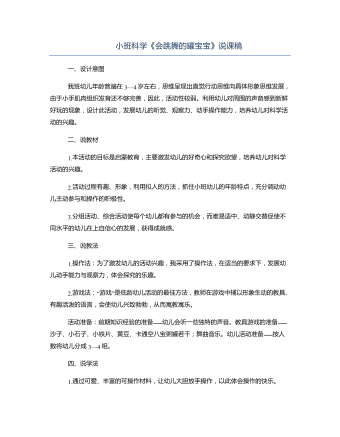
小班科学《会跳舞的罐宝宝》说课稿
二、说教材1.本活动的目标是启蒙教育,主要激发幼儿的好奇心和探究欲望,培养幼儿对科学活动的兴趣。2.活动过程有趣、形象,利用拟人的方法,抓住小班幼儿的年龄特点,充分调动幼儿主动参与和操作的积极性。3.分组活动、综合活动使每个幼儿都有参与的机会,而难易适中、动静交替促使不同水平的幼儿在上自信心的发展,获得成就感。三、说教法1.操作法:为了激发幼儿的活动兴趣,我采用了操作法,在适当的要求下,发展幼儿动手能力与观察力,体会探究的乐趣。2.游戏法:“游戏”是低龄幼儿活动的最佳方法,教师在游戏中辅以形象生动的教具、有趣活泼的语言,会使幼儿兴致勃勃,从而寓教寓乐。
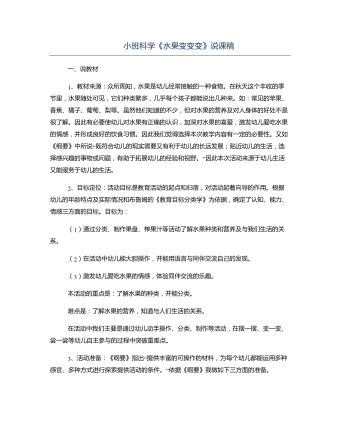
小班科学《水果变变变》说课稿
2、目标定位:活动目标是教育活动的起点和归宿,对活动起着向导的作用。根据幼儿的年龄特点及实际情况和布鲁姆的《教育目标分类学》为依据,确定了认知、能力、情感三方面的目标。目标为:(1)通过分类、制作果盘、榨果汁等活动了解水果种类和营养及与我们生活的关系。(2)在活动中幼儿能大胆操作,并能用语言与同伴交流自己的发现。(3)激发幼儿爱吃水果的情感,体验同伴交流的乐趣。本活动的重点是:了解水果的种类,并能分类。难点是:了解水果的营养,知道与人们生活的关系。在活动中我们主要是通过幼儿动手操作、分类、制作等活动,在摆一摆、变一变、尝一尝等幼儿自主参与的过程中突破重难点。3、活动准备:《纲要》指出“提供丰富的可操作的材料,为每个幼儿都能运用多种感官、多种方式进行探索提供活动的条件。”依据《纲要》我做如下三方面的准备。(1)学具准备:幼儿收集的各类水果并已洗好、水果刀、装饰果盘的辅助物、榨汁机.幼儿操作用的桌子三张(2)经验准备:幼儿对水果有一定的经验(认识几种常见水果)。(3)教具准备:孙悟空及制作果盘的多媒体课件。
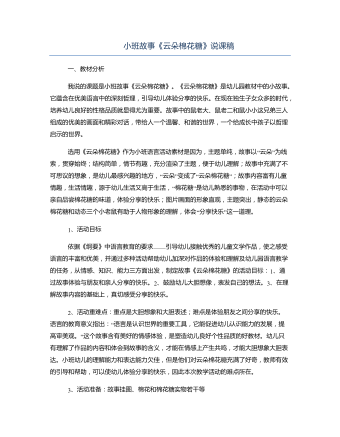
小班故事《云朵棉花糖》说课稿
1、活动目标依据《纲要》中语言教育的要求——引导幼儿接触优秀的儿童文学作品,使之感受语言的丰富和优美,并通过多种活动帮助幼儿加深对作品的体验和理解及幼儿园语言教学的任务,从情感、知识、能力三方面出发,制定故事《云朵棉花糖》的活动目标:1、通过故事体验与朋友和亲人分享的快乐。2、鼓励幼儿大胆想像,表发自己的想法。3、在理解故事内容的基础上,真切感受分享的快乐。2、活动重难点:重点是大胆想象和大胆表述;难点是体验朋友之间分享的快乐。语言的教育意义指出:“语言是认识世界的重要工具,它能促进幼儿认识能力的发展,提高审美观。”这个故事含有美好的情感体验,是塑造幼儿良好个性品质的好教材。幼儿只有理解了作品的内容和体会到故事的含义,才能在情感上产生共鸣,才能大胆想象大胆表达。小班幼儿的理解能力和表达能力欠佳,但是他们对云朵棉花糖充满了好奇,教师有效的引导和帮助,可以使幼儿体验分享的快乐,因此本次教学活动的难点所在。
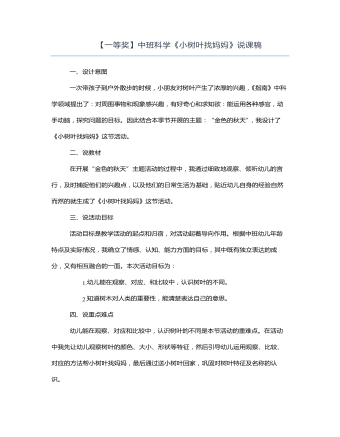
中班科学《小树叶找妈妈》说课稿
二、说教材在开展“金色的秋天”主题活动的过程中,我通过细致地观察、倾听幼儿的言行,及时捕捉他们的兴趣点,以及他们的日常生活为基础,贴近幼儿自身的经验自然而然的就生成了《小树叶找妈妈》这节活动。三、说活动目标活动目标是教学活动的起点和归宿,对活动起着导向作用。根据中班幼儿年龄特点及实际情况,我确立了情感、认知、能力方面的目标,其中既有独立表达的成分,又有相互融合的一面。本次活动目标为: 1.幼儿能在观察、对应、和比较中,认识树叶的不同。 2.知道树木对人类的重要性,能清楚表达自己的意思。四、说重点难点幼儿能在观察、对应和比较中,认识树叶的不同是本节活动的重难点。在活动中我先让幼儿观察树叶的颜色、大小、形状等特征,然后引导幼儿运用观察、比较、对应的方法帮小树叶找妈妈,最后通过送小树叶回家,巩固对树叶特征及名称的认识。

大班音乐《顽皮的小绅士》说课稿
确定恰当的教学目标,这是有效教学的核心。根据大班幼儿的发展水平、经验和对教材的理解,我从情感态度、能力和认知三个维度确定了本次活动的目标:1、学会用右脚起步,有节奏地跟音乐走踢踏步。2、在手套的提示下,发现并明确手套在舞蹈队形交换的提示作用,及时地转换动作和交换舞伴。3、体验小绅士快乐的心情,表现顽皮神气的神态。我确立了目标的整合观、科学观、系统观,使活动呈现趣味性、综合性和活动性。《纲要》的基本点是以儿童发展为本的现代幼儿教育理念,使幼儿乐意参与活动。因此,我把学会用右脚起步,有节奏地跟音乐走踢踏步确立为本次教学活动的重点,把在手套的提示下,发现并明确手套在舞蹈队形交换的提示作用,及时地转换动作和交换舞伴确立为本次教学活动的难点。良好的活动准备为每个活动环节打下了坚实的基础。为了更好地服务于本次活动目标和完成内容,我做了以下准备:1、知识经验准备:幼儿已有ABA音乐段式的知识经验。2、物质准备:白手套(若干,戴在右手上)、帽子一顶、绅士图片一幅。地上画一个大圆圈。音乐磁带,录音机。在活动过程中,白手套得到了反复的使用,体现了教具的有效性。

中班数学《小刺猬的项链》说课稿
二、说教材《指南》里的典型性表现说:中班的孩子能对事物或现象进行观察和比较,发现其相同与不同,喜欢动手动脑。他们常常在游戏时进行排列,比如拼插雪花片玩具,你会发现排列颜色是有规律的。积木搭建的小路,你也会发现小路石块也是有规律的,这些都说明他们对排序感兴趣。年龄层次方面,《小刺猬的项链》是幼儿园中班的下学期一节活动,幼儿的年龄大约都在4岁半—5岁。在生活经验方面,孩子们对排列有一定的生活经验积累,对周围常见的生活场景有一定的观察和比较;在知识方面,中班幼儿已经积累和建立了有关物体在颜色、形体和大小等特征差异上的简单排序的数学经验,可以更进一步地学习按照物的多个特征和数量进行不同的排序。在学习能力方面,吸纳外部信息的能力强,会掌握和理解新知识。三、说活动目标根据中班孩子的年龄特点和实际情况,我确立了认知、技能、情感这三方面的目标和重难点:(1)在欣赏与讲述中理解绘本内容同时巩固间隔排序的经验。(2)学习简单的按规律排序并大胆尝试自编规律。(3)懂得并感受分享是一件快乐的事情。四、说重点难点规律排列的数学活动重点是:在欣赏与讲述中理解绘本内容同时巩固间隔排序的经验。难点:学习简单的按规律排序并大胆尝试自编规律。
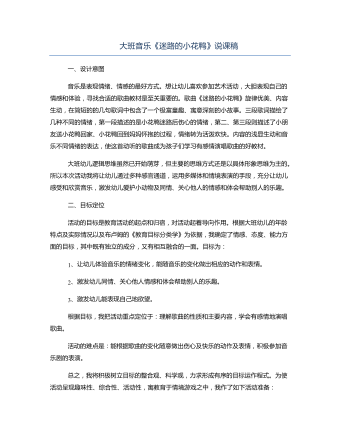
大班音乐《迷路的小花鸭》说课稿
二、目标定位活动的目标是教育活动的起点和归宿,对活动起着导向作用。根据大班幼儿的年龄特点及实际情况以及布卢姆的《教育目标分类学》为依据,我确定了情感、态度、能力方面的目标,其中既有独立的成分,又有相互融合的一面。目标为:1、让幼儿体验音乐的情绪变化,能随音乐的变化做出相应的动作和表情。2、激发幼儿同情、关心他人情感和体会帮助别人的乐趣。3、激发幼儿能表现自己地欲望。根据目标,我把活动重点定位于:理解歌曲的性质和主要内容,学会有感情地演唱歌曲。活动的难点是:能根据歌曲的变化随意做出伤心及快乐的动作及表情,积极参加音乐剧的表演。总之,我将积极树立目标的整合观、科学观,力求形成有序的目标运作程式。为使活动呈现趣味性、综合性、活动性,寓教育于情境游戏之中,我作了如下活动准备:1、经验准备:课前举行过有关于迷路的谈话,使幼儿对迷路及自救的方法有一定的了解。2、物质准备:关于歌曲的多媒体课件、歌曲磁带、鸭妈妈及小花鸭的头饰。3、空间准备:活动前幼儿的位置摆成半圆形,以利于幼儿进行表演。三、教法学法科学教法——轻松引领师幼互动新《纲要》指出:“教师应成为幼儿学习活动的支持者、合作者、引导者”。活动中应力求形成合作探究式的师生互动、生生互动。因此,本次活动中我除了以可爱、亲切的形象,饱满的情绪影响孩子外,我还精选了以下几种教学方法:
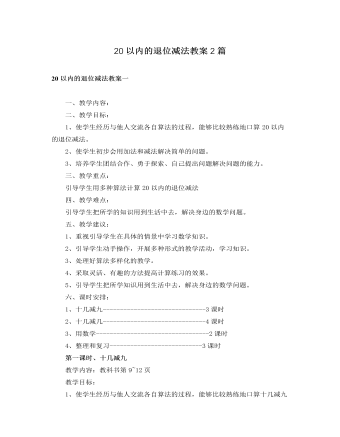
人教版新课标小学数学一年级下册20以内的退位减法教案2篇
一、揭题:小朋友们,今天我们一起来做练习。二、练习:1、第8题:这是一道计算题。(1)明确要求:看谁算得又对又快。(2)学生独立完成。(3)订正答案。(4)有错的学生,说一说计算顺序是怎样的,每一步的计算结果是多少?2、第9题:这是一道用数学的题。(1)看图,同位两个互相说说图意,并提出数学问题。(2)根据问题列算式解答。(3)订正答案。3、第10题:比一比。(1)明确要求,看谁先夺得红旗。(2)各小组派代表参加比赛。(3)对算得又对又快的学生提出表扬,并奖励给一个小标志。(4)再加入几组比赛题,尽量让学生多参与。4、第11题:这是一道用数学的题。(1)看图,说图意,提出数学问题。(2)列算式解答,指名板演订正。(3)说一说为什么用加法计算?5、思考题:小组讨论完成。一共12人,每两人之间插入一个女生,一共能插入11人。
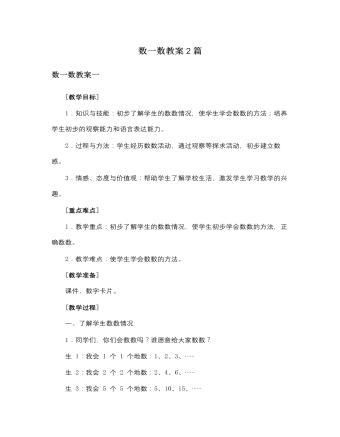
人教版新课标小学数学一年级上册数一数教案2篇
[在学生数的过程中再加强点数的指导,同时有意识的培养学生按顺序数数。另外,在数六朵花、八棵树、九名女生、十名男生的时候,除了 1 个 1 个地数以外,还可以引导学生 2 个 2 个地、3 个 3 个地、4 个 4 个地、5 个 5 个地数数,为后面学习 10 以内各数打基础。] (2)小组进行交流。 再从 1~10 数一数物体的个数。 (3)认一认。 师:你认识这些数吗?边指边读给大家听听。 生:边指 1~10 各数边读一读。 三、巩固练习 1.结合实物,开展数数活动。 (1)按要求数出下面物体的个数。 师:同学们刚才数得真不错!你们愿不愿意数一数自己文具盒中有几支铅笔呀? 生:数出自己文具盒中有几支铅笔并汇报。 师:请同学们数一数你的书包里共有几本书? 生:数出自己书包里共有几本书并汇报…… (2)自由数物体的个数。 师:你还想数哪些物体的个数?和同桌的小伙伴交流一下。
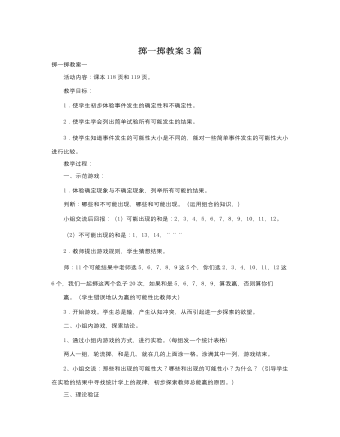
人教版新课标小学数学三年级上册掷一掷教案3篇
3、开始游戏。学生总是输,产生认知冲突,从而引起进一步探索的欲望。(二)小组内游戏,探索结论。通过小组内游戏的方式,进行实验,利用统计的方式呈现实验的结果,初步探索教师总能赢的原因。要引导学生在实验的结果中寻找统计学上的规律。(三)理论验证通过组合的理论来验证实验的结果。可以用不同的方式来进行组合,让学生探讨每个“和”所包含的组合情况的多少与这个“和”出现的次数之间的关系。三、师生共同小结本次活动1、通过本次活动,你有什么新的收获?2、师生总结:本次活动通过猜想、实验、验证等过程,让同学们在问题情境中自主探索,解决问题,既发展了同学们的动手实践能力,又充分调动了同学们的学习兴趣。

人教版新课标高中地理必修2第二章第一节城市内部空间结构教案
为城市居民提供休养生息的场所,是城市最基本的功能区.城市中最为广泛的土地利用方式就是住宅用地.一般住宅区占据城市空间的40%—60%。(阅读图2.3)请同学讲解高级住宅区与低级住宅区的差别(学生答)(教师总结)(教师讲解)另外还有行政区、文化区等。而在中小城市,这些部门占地面积很小,或者布局分散,形成不了相应的功能 区。(教师提问)我们把城市功能区分了好几种,比如说住宅区,是不是土地都是被居住地占据呢?是不是就没有其他的功能了呢?(学生回答)不是(教师总结)不是的。我们说的住宅区只是在占地面积上,它是占绝大多数,但还是有土地是被其它功能占据的,比如说住宅区里的商店、绿化等也要占据一定的土地, 只是占的比例比较小而已。下面请看书上的活动题。

人教版高中语文必修3《马嵬(其二)》教案2篇
结合历史自古以来,江山美人历来都是引无数英雄豪杰竞折腰的,如果说英雄选择了美人却丢了江山,把所有罪名都归结于“女人是祸水”。但是,纣王无道,和有了妲己有必然的联系吗?有人说妲己坏透了,坏透了的妲己如果不是取得纣王的信任是坏不起来的,纣王听信了妲己的谗言,听与不听决定权在纣王,而不在妲己。强势永远在纣王一边。再来看看西施和杨贵妃:西施是作为越国贡献给吴国的供品来到吴王夫差的身边的,杨贵妃更是先是李隆基的儿媳妇被看中而得宠的。所以,西施和杨贵妃这两个可怜的女人根本没有自己的独立选择,没有独立的爱情,如果没有西施,就会有南施,或北施;如果没有杨贵妃,就会有李贵妃,王贵妃,总之什么施,什么妃是不能少的,因为那是吴王和李隆基的需要。

新人教版高中英语必修2Unit 1 Cultural Heritage-Discovering Useful Structure教案二
This theme of the part is “ Describe people or things in greater detail”. Students have learned the grammar(restrictive relative clauses) in Book 1, and further review and consolidate its structure “prep+relative pronouns(which/whom)” and the relative adverbs(when, where and why), besides students should understand its form, meaning and functions. In this section, students should be able to express the grammar correctly in daily communication and in the writing. 1. Review the basic usages of relative pronouns and adverbs of attributive clauses . 2. Learn to use some special cases about restrictive relative clauses.3. Learn to write sentences with restrictive relative clauses flexibly according to the context.1. Review the basic usages of relative pronouns and adverbs of attributive clauses .2. Learn to use some special cases about restrictive relative clauses.3. Learn tow rite sentences with restrictive relative clauses flexibly according to the context.Step 1. Observe the following sentences, and mark the relative pronouns and the adverbs. 1. After listening to the scientists who had studied the problems, and citizens who lived near the dam, the government turned to the United Nations for help.2. Temples and other cultural sites were taken down piece by piece, and then moved and put back together again in a place where they were safe from the water.Step 2 PracticePlease complete these sentences with relative pronouns and relative adverbs and answer the following questions.Questions: 1. What is the head noun ?2. What relative words should be used ?3. What elements do they act in these sentences ?

新人教版高中英语必修2Unit 2 Wildlife Protection-Reading for Writing教案二
This lesson aims at making a poster about protecting wildlife after reading some posters. During reading students are guided to understand the content and try to summarize the posters with one sentence. Then students are guided to try to make a poster about protecting wildlife.1. Read the two posters and try to understand the summary sentences.2. Look at the two posters and try to understand what emotions they express.3. Try to summarize the features of posters4. Try to make a poster about wildlife.1. Look at the two posters and try to understand what emotions they express.2. Try to summarize the features of posters3. Try to make a poster about wildlife.Step 1 Lead inLook at the the posters on the textbook and ask:Which emotions do the posters communicate ?Step 2 Read the poster and answer the questions.1. What do you think of the animals in the poster on the left ?I think it is frightening and ugly.2. Why do we should protect the ugly animals ?All species--the good, the bad, and the ugly-- should be treated equally.The world needs all kinds--without variety, our planet cannot survive.3. Why are billions of trees being cut down every year ?To make paper for humans.4. What result will be lead to after the trees are cut down ?A lost of animal homes are being destroyed./The habitat of wildlife is being destroyed.Step 3 Find the feature of posters1. What does each poster use to stir up emotions ?On the left, it makes us a little frightened and it looks a little ugly, but it can activate our curiosity--What is it? And What is wrong with it?On the right, it makes us feel a little sad and want to protect them.
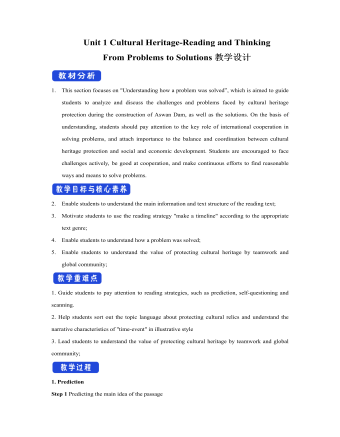
新人教版高中英语必修2Unit 1 Cultural Heritage-Reading and Thinking教案二
1. This section focuses on "Understanding how a problem was solved”, which is aimed to guide students to analyze and discuss the challenges and problems faced by cultural heritage protection during the construction of Aswan Dam, as well as the solutions. On the basis of understanding, students should pay attention to the key role of international cooperation in solving problems, and attach importance to the balance and coordination between cultural heritage protection and social and economic development. Students are encouraged to face challenges actively, be good at cooperation, and make continuous efforts to find reasonable ways and means to solve problems.2. Enable students to understand the main information and text structure of the reading text;3. Motivate students to use the reading strategy "make a timeline" according to the appropriate text genre;4. Enable students to understand how a problem was solved;5. Enable students to understand the value of protecting cultural heritage by teamwork and global community;1. Guide students to pay attention to reading strategies, such as prediction, self-questioning and scanning.2. Help students sort out the topic language about protecting cultural relics and understand the narrative characteristics of "time-event" in illustrative style3. Lead students to understand the value of protecting cultural heritage by teamwork and global community;

新人教版高中英语必修2Unit 2 Wildlife Protection-Discovering Useful Structure教案二
2.表示现阶段正在进行的被动动作(该动作在说话的瞬间未必正在进行)。Many interesting experiments are being carried out these days.(说话时,并不一定正在进行)3.表示一种经常性的被动行为,常和always,constantly 等表示频度的副词连用,这种用法常常带有赞扬或厌恶的感情色彩。He is always being praised by the leader.4.表示按计划或安排主语将要承受谓语动词所表示的动作(仅限于少数及物动词)。A party is being held tonight.Step 4 Special cases1.像take care of, look after, talk about, think of等动词与介词构成的短语用于现在进行时的被动语态时, 其中的介词不可省略。The ways to stop illegally hunting are being talked about. 2.可与部分情态动词连用,表示对正在发生的事情的推测。She may be being punished by her mother.3.有时可表示按计划或安排将要进行的一个被动动作。A celebration is being held this weekend for his success.4.某些表示“状态、心理活动、存在”等的动词,如have,want,need,love,一般不用现在进行时的被动语态,而常用一般现在时的被动语态。With the population increasing,more land is needed.5.“be+under/in+n.”可表示现在进行时的被动意义。My computer is under repair.=My computer is being repaired.

新人教版高中英语必修2Unit 2 Wildlife Protection-Reading and Thinking教案二
The theme of this unit is human and nature, focusing on the theme of wildlife protection. Nature is a complex ecosystem, in which there are delicate balance between animals and plants. Because of the role of the food chain, the extinction of one species will produce influence, causing a series of chain reaction. Large scale extinction of species will have a serious and even irreversible impact on the ecosystem, resulting in immeasurable losses. Therefore, it is of great significance to protect wild species. To protect wild species is to protect human beings themselves. The motto of this unit is "when the buying stops, the killing can too,” which is a public service advertising slogan to protect wildlife. It tells people that every rhinoceros horn, every fur, every bowl of shark fin soup, every Ivory product, and every tiger bone product, etc. consumed by human beings, are innocent wild animals slaughtered behind them. The mission of wild aid is to ban illegal trade in endangered wildlife and mitigate climate change. It aims to educate the public to reduce the consumption demand for endangered wildlife products through public publicity and improve the awareness of environmental protection.1. Improve the awareness of wildlife protection by acquiring the knowledge of wildlife protection.2. Focus on environmental protection and protection of all lives.3. Analysis of the living environment of wild animals with appropriate thinking mode.4. Skillfully use the vocabulary and grammar knowledge of this unit to cultivate self-study ability according to the unit content5. Develop cooperative learning ability through discussion and other ways1. Enable the Ss to talk about the current situation of wild animals.2. Guide the Ss to summarize the main idea of each paragraph as well as the main idea of the text.

新人教版高中英语必修2Unit 3 The Internet-Discovering Useful Structure教案二
This teaching period mainly deals with grammar “The Present Perfect Passive Voice.” To begin with, teachers should lead students to revise what they have learned about the Present Perfect Passive Voice. And then, teachers move on to stress more special cases concerning this grammar。This period carries considerable significance to the cultivation of students’ writing competence and lays a solid foundation for the basic appreciation of language beauty. The teacher is expected to enable students to master this period thoroughly and consolidate the knowledge by doing some exercises. 1. Guide students to review the basic usages of the Present Perfect Passive Voice2. Lead students to learn to use some special cases concerning the Present Perfect Passive Voice flexibly.2. Enable students to use the basic phrases structures flexibly.3. Strengthen students’ great interest in grammar learning.1. Help students to appreciate the function of the Present Perfect Passive Voice in a sentence2. Instruct students to write essays using the proper the Present Perfect Passive Voice.观察下列句子特点,总结共同点。1.(教材P28)Much has been written about the wonders of the World Wide Web.2.(教材P28)But the Internet has done much more for people than simply make life more convenient.3.(教材P28)Many people have been helped by the club.4.(教材P28)She no longer feels lonely, and her company has become quite successful.5.(教材P32)Today I thought I’d blog about a question that has been asked many times—how do you stay safe online and avoid bad experiences on the Internet?

